NAIA Turntable—In Rega World Less Is More, More Or Less
takes Rega performance to a new level
Written by Bill Philpot, the late Paul Messenger and Rega co-founder Roy Gandy, “A Vibrational Measuring Machine” released in 2016 chronicles Rega Research’s long, rich history and the evolution of its design concepts. In its quest to create and market the ultimate “vibration measuring machine”, Rega Research has over the years worked diligently, you could say almost ruthlessly to reduce mass and increase the rigidity of its turntables.

A low mass, stiff plinth (or whatever you wish to call the platform that holds the platter bearing and tonearm) is essential, Rega argues, to thwart the transfer to the platter surface of bearing and motor noise as well as to minimize the intrusion upon the system of outside vibrations, both airborne and surface produced.
Properly executed, super low mass, rigid designs evaporate unwanted energy like water droplets hitting hot pavement. Rega has been averring and proving that for many years. That doesn’t mean it’s the only approach to turntable design, but it’s certainly a valid one.
In Rega-world, both low and high mass systems improperly executed create problems. Low mass mechanically soft ones can vibrate at high frequencies like drums and that’s obviously not good, while high mass ones can resonate at low frequencies that are difficult to stifle and so linger and produce unacceptably muddy, “slow” sound. Mass alone can’t sink low frequency resonances.
Rega’s argument has always been that light and stiff obviates the need for high mass and that deep, "tuneful" bass production has nothing whatsoever to do with high mass.
The goal is to produce a turntable/tonearm combination that accurately reads the vibrations produced by the stylus coursing through the groove while not reading extraneous ones produced by motors or bearings or coming in from the outside world, or perhaps the most pernicious of all, vibrations produced in reaction to the ones produced by the stylus/groove interface.
Of course, there’s more to producing a great turntable than a light, stiff plinth that effectively holds the bearing in place. Bearing quality itself is critical both for accurate platter rotation and low noise, and low vibrational energy.
And because what’s being measured is stylus velocity/displacement (unless the cartridge is optical or strain gauge in which case it measures amplitude), speed consistency is as critical as speed accuracy. Motors vibrate and there are “steps” between motor poles that must be smoothed out. Rega prefers belts (round “O-ring” types actually, but not actually “O-rings”) to help smooth out motor vibrations.
Platters must have sufficient mass and stiffness to further reduce motor produced vibrations and to deal with bearing produced ones. Mass properly placed on a platter enhances flywheel behavior that further improves rotational consistency.
Tonearms present their own set of performance variables most readers here have explored so let’s not get into those in this admittedly simplified overview, other than to remind you that Rega values rigidity over adjustability so Rega arms provide no adjustments for azimuth or VTA/SRA. You are at the mercy of your cartridge manufacturer.
In 2017 I visited Rega for the third time and got to see the then still in the experimental stage Naiad, which represented and still represents the ultimate in Rega’s thinking. Though it was originally intended as a non-production design akin to what automobile manufacturers display at car shows, due to fan demand Rega made and sold a few $45,000 Naiads.
Based on Naiad research and using today’s highest tech materials, Rega has over the past few years produced a series of high performance, lightweight turntables that are its best performing yet: the Planar 8 and Planar 10, both of which I’ve reviewed. They are super-rigid and super-lightweight, and their motors are controlled by sophisticated electronics that allow for speed to be precisely adjusted and motor vibrations minimized, with each motor “tuned” to its PSU mate.
The Planar 8, which offers a lightweight plinth, with rigid RB880 tonearm, Neo PSU that provided electronic speed control and fine speed adjustment, without cartridge costs $3495.
The Planar 10 is more “Naiad-like” and features an even lighter and more rigid plinth, an upgraded ceramic oxide platter, a newly developed machined aluminum subplatter/hardened steel spindle riding in a brass bushing and a new RB3000 arm. It sells for $5695 without cartridge and as with the Planar 8, package deals with Rega cartridges produce considerable savings.
NAIA Ups The Performance, And the Price
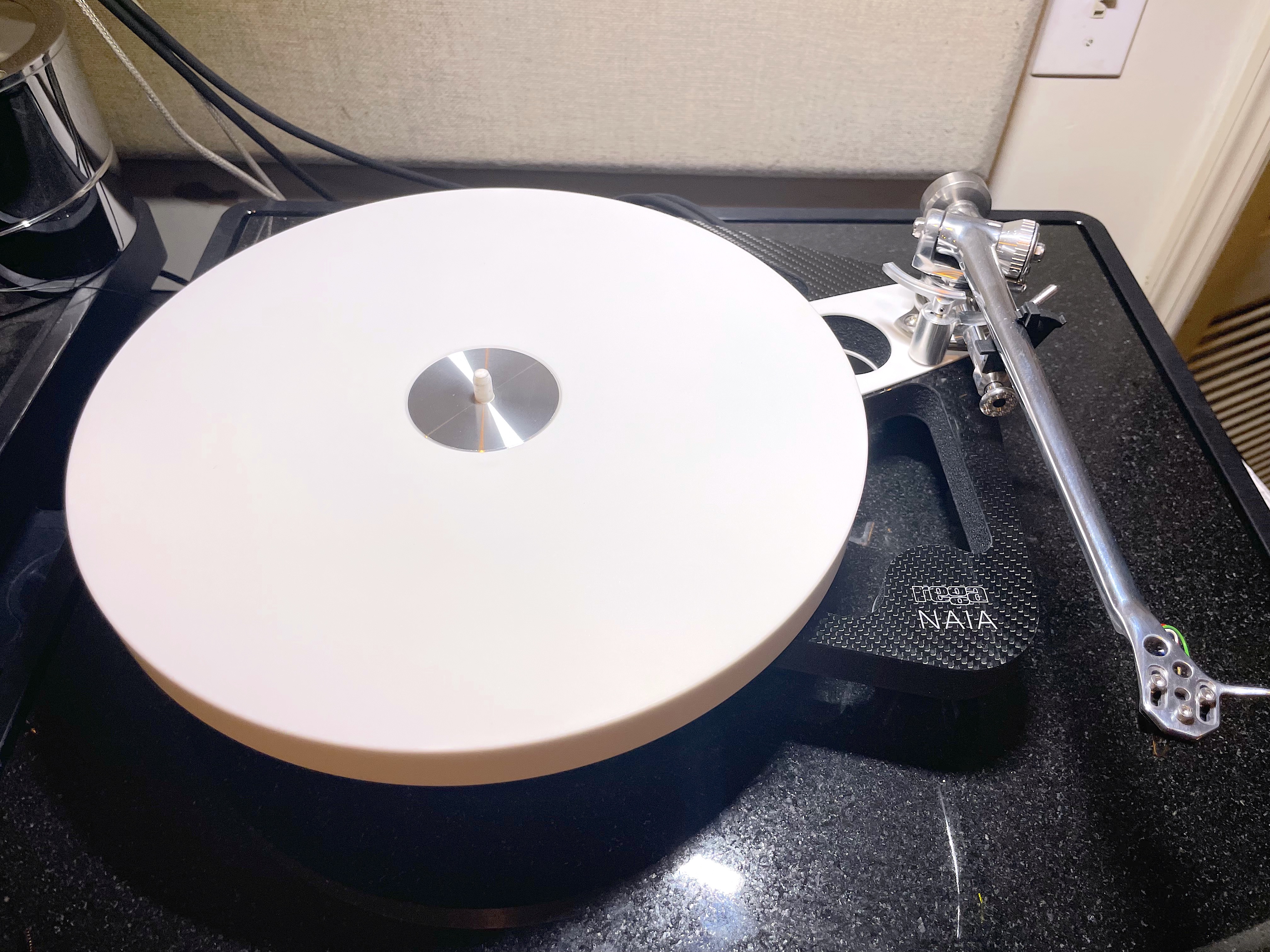
Like the Planar 10, the NAIA is based upon Rega’s hand-made, Naiad, but it takes everything up more than a few Emeril Lagasse-like notches, bringing it closer to the Naiad technologically and, unfortunately, in price. At $12,995 without cartridge, the NAIA is more than double the price of the Planar 10 and by far, Rega Research’s most expensive normal production turntable ever.
Why the price jump? The Naia uses a Graphene impregnated carbon fiber skeletal plinth with Tancast 8 foam core sandwiched between the Graphene outer skins. The Planar 10 uses the same Tancast 8 foam core, with a not nearly as stiff high pressure laminate skin.
The NAIA uses two ceramic aluminum oxide braces, one on top and one on the bottom, instead of the Planar 10s single ceramic brace on top and a less-stiff phenolic brace on bottom. The second ceramic brace adds considerable additional rigidity.
Rega further upgrades its familiar looking tonearm to the RB Titanium version that includes a one-piece titanium vertical bearing, a titanium vertical spindle assembly and a tungsten counterweight and counterweight stub. These are more than cosmetic changes as anyone who’s experimented with various metals in these positions can affirm.
I can. I just evaluated two versions of a cartridge, one with a titanium body and one of aluminum, with the same inside guts and they sounded completely different from one another, timbrally and especially dynamically.
A new ceramic oxide platter features a larger center opening compared to that of the Planar 10’s, to accept the new aluminum sub-platter’s mount featuring a spindle and central bearing manufactured from ZTA (zirconium toughened alumina). That’s among the NAIA's most significant performance upgrades and a major cost driver.
ZTA is an abrasion resistant ceramic material developed for industrial use that Rega says is perfect for a central bearing assembly except that it’s extremely costly and difficult to manufacture. It starts life as a powder and after a complex process not necessary to detail here, gets fired for three days at 1600 degrees Celsius. The finished bearing must then be honed to precisely fit the ZTA spindle. The “perfect fit” matched pair remain together and are then assembled within the NAIA plinth.
Because the spindle and bearing are manufactured of the same exceptionally hard material (as opposed to the more typical hardened steel spindle/brass bush bearing), wear is minimal to non-existent, especially since the spindle runs on a super-thin layer of synthetic oil. Rega claims this produces the longest lasting, most accurate bearing assembly it has ever produced. No doubt it’s also the costliest. Obviously such a smooth-running, precision assembly reduces to a minimum friction and thus unwanted vibrations at a juncture where it's easiest to transmit to the platter and thus to the cartridge.
The triple “O-ring” aluminum sub-assembly is by far Rega’s most complex. I put “O-ring” in quotes because Rega’s round belt made of EPDM (ethylene propylene diene monomer) is not your typical irregular half-construct "off the shelf" “O-ring”, though it sort of resembles one. Instead, the company has paid its usual fanatical attention to R&D detail to produce one that won’t beat one against the other in a triple line-up and do more damage than good to speed accuracy.
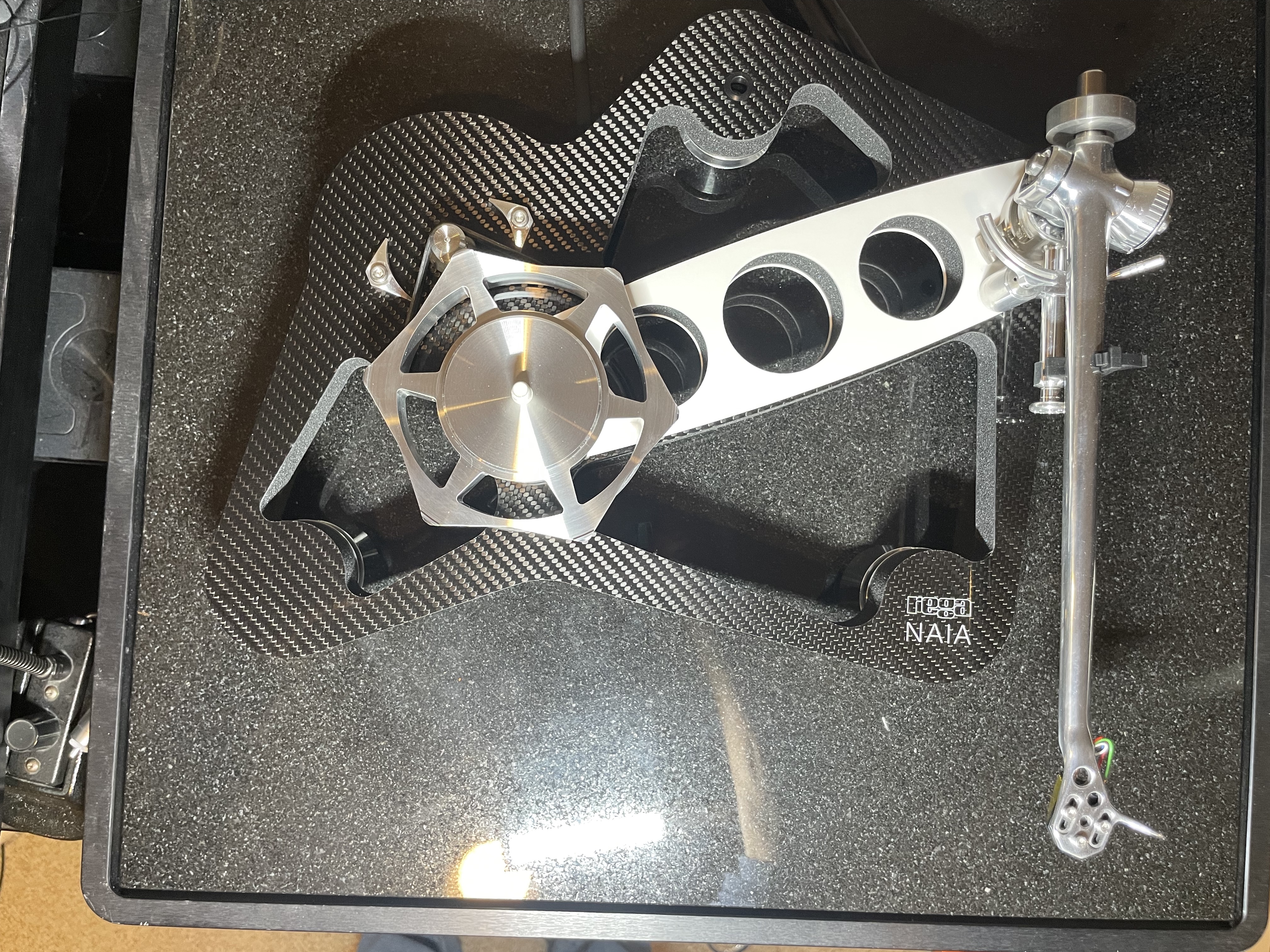 NAIA subplatter
NAIA subplatter
Three years of work produced a new specially cured rubber drive belt compound that exhibits a consistent elasticity and is manufactured on Rega designed tooling that the company says produces “perfectly round” and “dimensionally accurate” belts, necessary for “perfect speed stability”. Anyone who considers this level of attention to detail plain old audiophile “snake oil” posturing hasn’t taken the time to consider the infinitesimal dimensions of groove etchings and how important all these nuanced improvements can be to improving easily heard sonic performance.
The literature doesn’t make clear how or if the NAIA “Reference Power Supply” that drives the 24v low noise bi-phase AC motor (also used on other less costly Regas) differs from what’s used on the Planar 8 and Planar 10 but it drives the motor using a crystal controlled DSP square wave generator that produces a “near perfect” sine wave. Each paired motor/PSU is hand-tuned to minimize vibration and fine speed adjusted. If need be, though it’s not likely, you can fine-adjust speed in 0.01rpm steps or return to the factory setting.
Some readers think a plinth-mounted motor means noise. The Planar 10 I reviewed elsewhere used a new motor mount system developed from the Naiad that was claimed to be even more effective in reducing noise. Listening with a stethoscope to the Planar 10's top "skin" produced a very low-level rotation start up sound that, when the platter reached speed, was barely perceptible.
This wasn’t sufficiently satisfying for some in the peanut gallery commenting below the review (though outboard motors mounted on pods often produce more noise depending upon how well they are damped and upon what surface they are placed), so how about this? While it was difficult to find a NAIA surface upon which to place a stethoscope drum, when I finally did manage, there was no audible noise with the motor at speed and a ridiculously low amount upon start up. The NAIA motor mount is a further developed version.
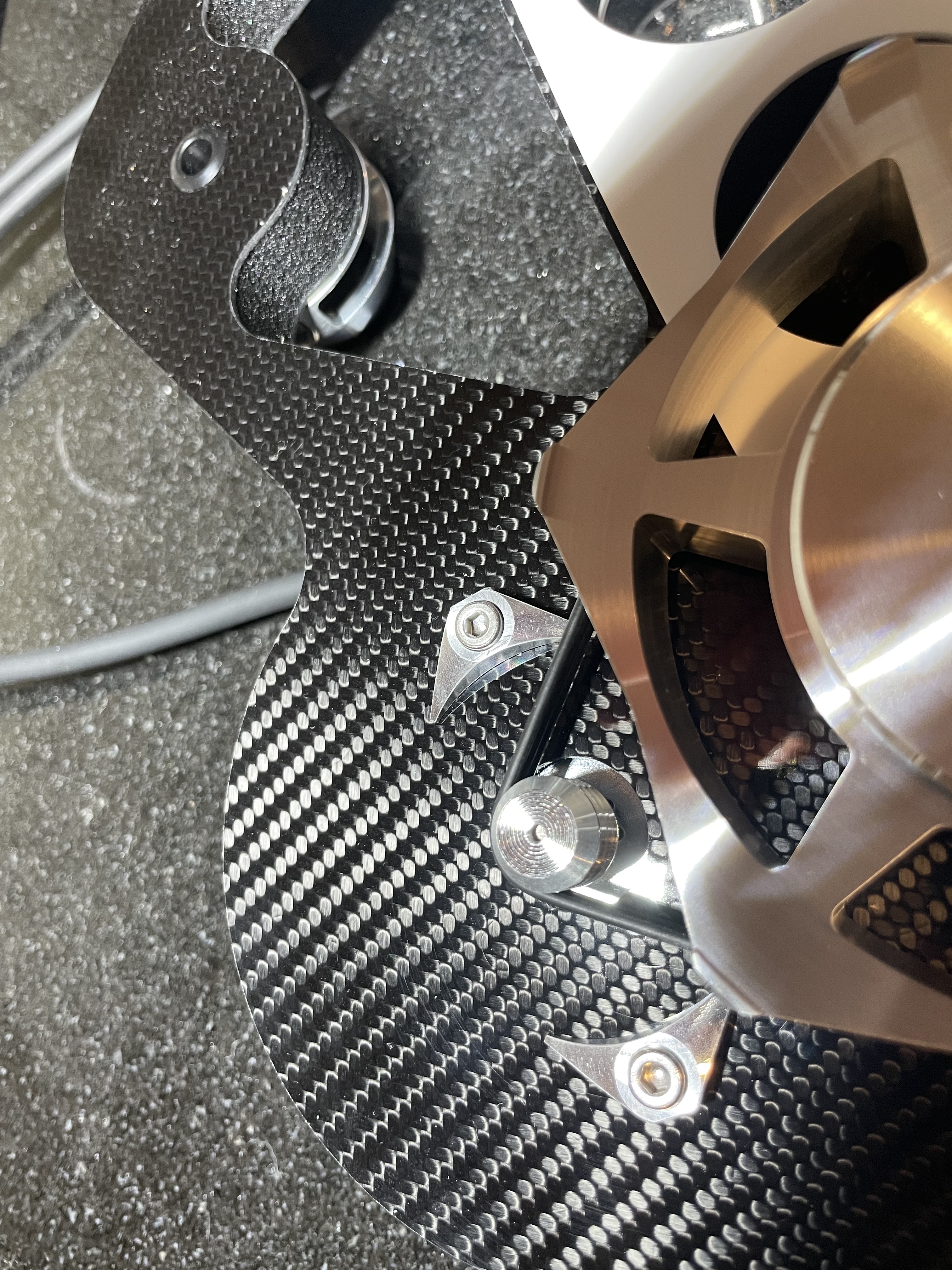 Motor mount as seen from above
Motor mount as seen from above
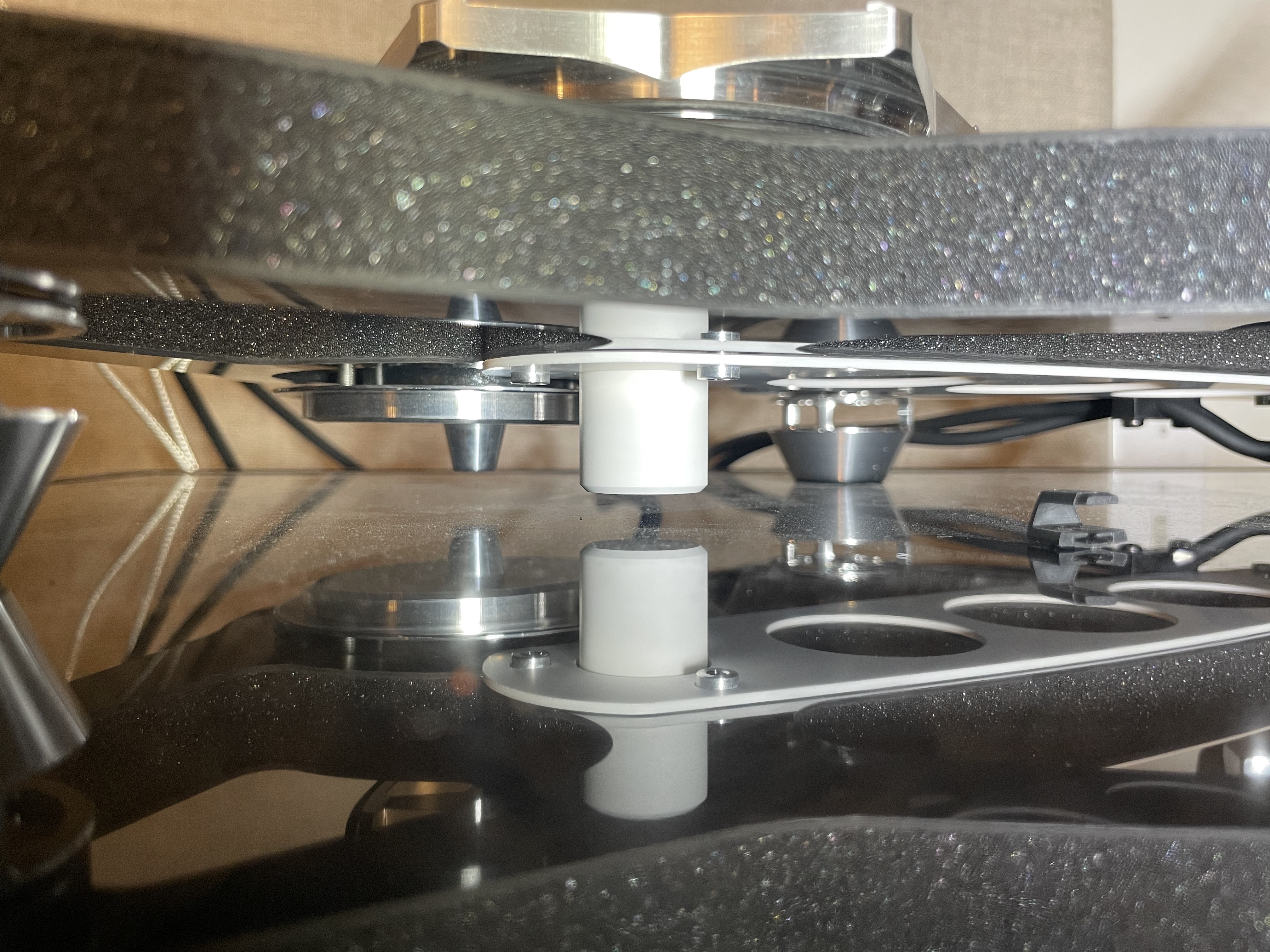 motor mount as seen from below (white cylinder is ceramic bearing housing)
motor mount as seen from below (white cylinder is ceramic bearing housing)
While the online Planar 10 manual includes specifications like PSU weight (3kg), dimensions and turntable weight (4.7kg), the NAIA manual, both printed and online doesn’t provide this information so I couldn’t confirm that the PSU used on both is identical, but I assume it is.
New ultra-low mass “skeletal” aluminum feet complete the product description. Oh! And there’s a very useful, easy to use, space saving dustcover that protects platter and tonearm, which is a good idea since in keeping with Rega consistency, the mat is a dust attracting fiber one like what’s used throughout the line. I’m not trying to be “smart” here. I appreciate the line continuity and I understand that Rega likes the mat because it feels this mat provides the best record/platter coupling. I just don’t, especially when it clings to the record upon lift off, breaks free and threatens the stylus’s health and well-being and is a dust magnet.
The Rega Aphelion 2 Moving Coil Cartridge
Rega’s latest premium moving coil cartridge is a third-generation design of a unique construction that does not require the usual rear-mounted tie wire to secure the cantilever assembly, or the usual elastomer damper held to a specified degree of tightness against the coil former, the front part of which produces the system’s fulcrum and all of which determines the cartridge’s compliance.
Instead, Rega’s design uses a long cantilever, here Boron, wherein the joint pipe that holds the cantilever is inserted into a larger diameter “holder” that fits through a rhomboid-shaped elastomer (red), which serves as both the system’s fulcrum, and the cantilever’s placeholder. For obvious reasons some sort of arrangement must be involved that prevents the cantilever from rotating within the elastomer on its longitudinal axis.
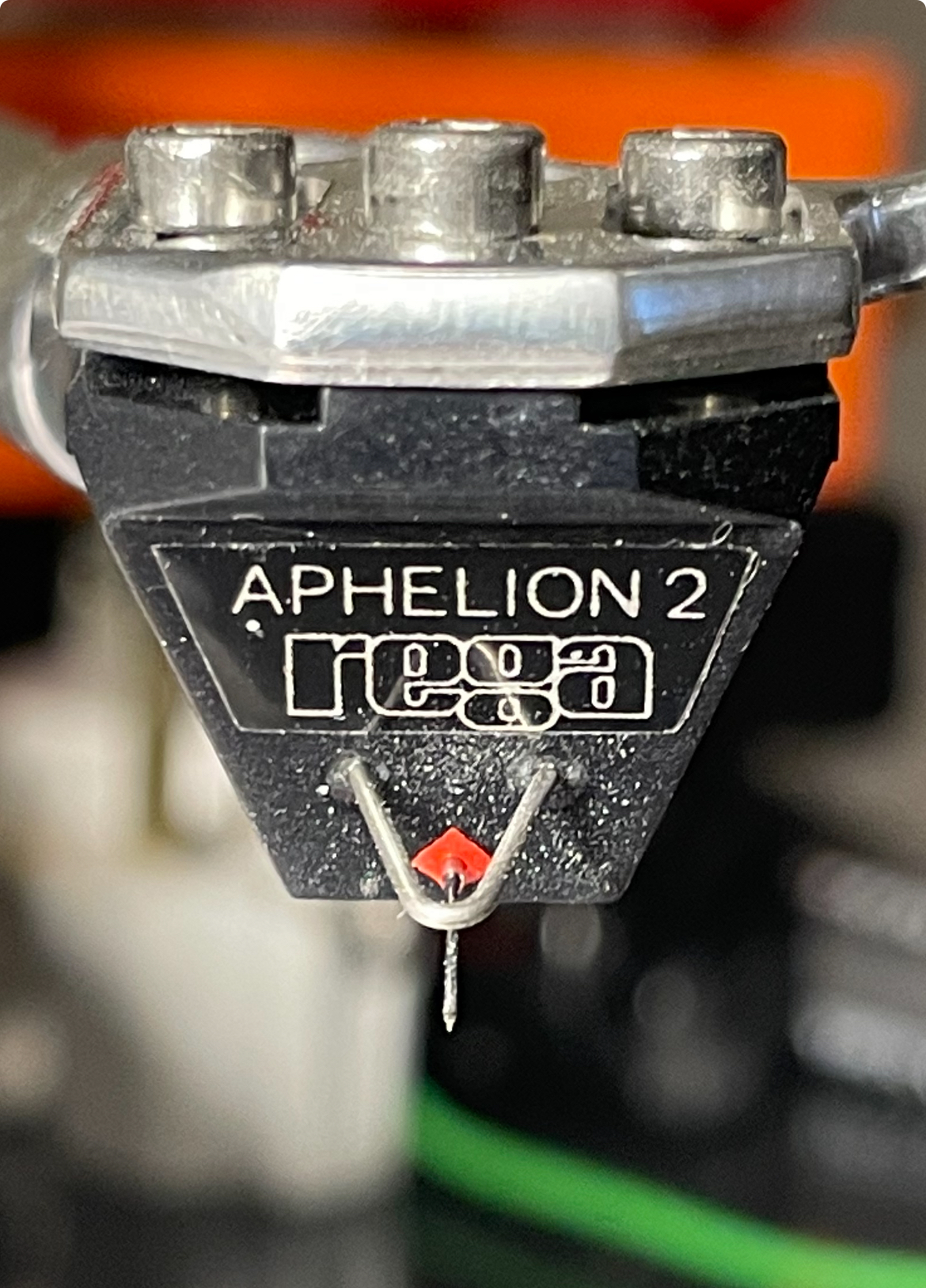
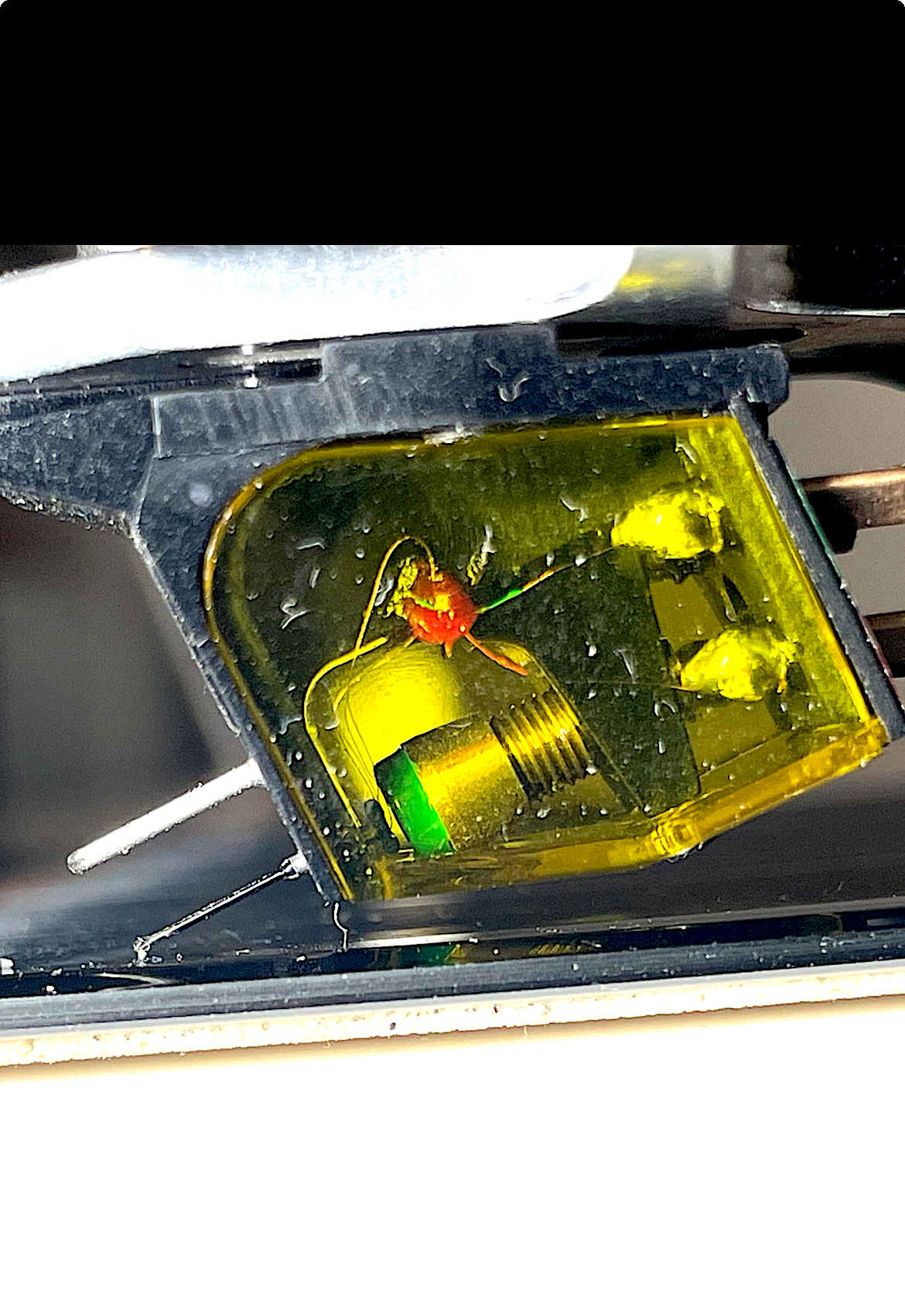
To one end is affixed (cemented) a nude “fine line” stylus, the radii of which Rega doesn’t provide in its specs. It appears to be Ogura-sourced but that isn’t certain. At the other end resides a “hand wound” magnetized micro-cross former wound with 0.018 mm wire, (I assume copper).
Because the sides of the precision machined “zero tolerance” aluminum housing are open and protected with a transparent laminate of some kind, you can see inside where what Rega claims is “the world’s most powerful neodymium magnet” (the green-fronted structure in the photo) is affixed to the end of a bolt threaded into a frame that holds it in place.
The distance from the coil former to the magnet can be adjusted, but what can’t be adjusted is the relative positioning of the bolt and the opening through which the cantilever goes and the lateral positioning of the bolt holder itself relative to the fulcrum point opening. All must be perfect or the ship sinks.
Of course, by “hand wound”, Rega means a trained individual works using a precision coil winding machine. You wouldn’t want a genuine “hand wound” coil on your cartridge—if that’s even possible.
A long cantilever can spell cleaning person, child or cat trouble but Rega has carefully thought this through. The front of the body features a curved paper-clip like protrusion that both partially protects the cantilever and acts as a holder for the stylus guard that easily slips over it (you can see that in the above cartridge front photo).
Suggested tracking force is 1.9-2.0g and as you can see in this construction, deviating much from that can easily degrade the magnet/coil relationship. Input load impedance is 100 ohms, output impedance is 10 ohms, output voltage is .35mV, channel balance is equal to or better than 0.1mV and “separation” is rated at equal to or greater than 29dB.
The Aphelion 2 costs $5,545. Bought in combination with the NAIA turntable, the total price becomes $16,995, meaning you’re getting the cartridge for $3995 or a considerable $1545 saving. Before you go for the NAIA/Aphelion 2 combo, you might consider other $4000 cartridges and spend the same $16,995.
Set Up
With the cartridge pre-installed, the Naia was out of the box and ready to play within ten or so minutes (on a perfectly level surface). Carefully lower the platter onto the hub, install the counterweight, balance and set tracking force, set anti-skating to second position, plug multi-pin connector into the PSU and you are ready to play records! It’s as easy to set up a high performance turntable as there is and so lightweight.
Keep in mind that Rega’s three bolt alignment produces a “quasi-Stevenson” alignment that compared to Löfgren or Baerwald variants produces more distortion over most of the record side, while helpfully moving the second null point considerably closer to the label than either of those.
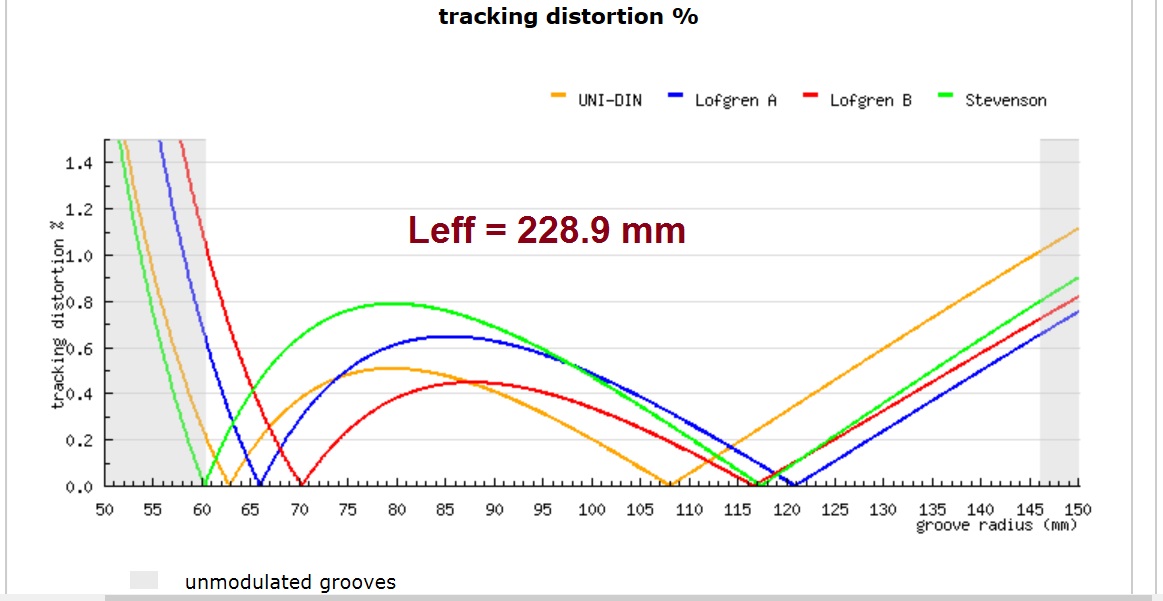
With “Rega/Stephenson” if you play mostly older classical records, you can often get to or past the big, difficult to track finales before distortion escalated beyond the second null point. If you mostly play newer records or double 45s that are cut to nowhere near the label, you’re getting more distortion with no benefit!
It's easy enough to remove the front screw and using a good alignment protractor (like the WallyTractor) try other alignments. If you don’t like the results just replace the third screw and you’re back in.
Which reminds me of a quick story: I was at the Dolby Theater for an Atmos demo and had to get signed in using an elaborate process that was almost like using Clear to get through airport security. A young publicity person helped me, and once I was good to go, she said “You’re in like Flynn!”. I said, “Do you know what “In like Flynn” means? She said “I don’t.” “The actor Errol Flynn was accused of rape and….”. Turning purple she said, “I had no idea!. I'll never say that again”.
Quick Cartridge Exam
When I reviewed the original introduced in 2006 Apheta cartridge (the first Rega cartridge to employ the unique no tie-wire design now in its 3rd generation) I appreciated what it did well but not by an annoying upper midrange sonic ledge that break-in didn’t eliminate. The original Apheta's stylus assembly orientation of negative 90 degrees (shown below) was not helpful to the sound!
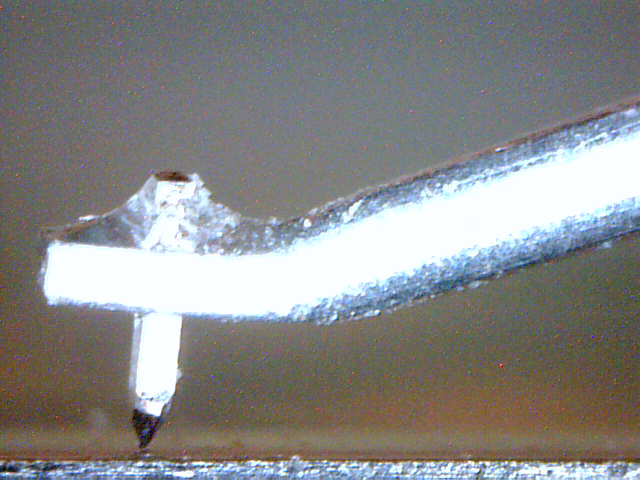
Happily, the Aphelion 2’s cantilever/ 'fine line' stylus assembly (which appears to be Ogura source, but I'm not sure) was manufactured perfectly and produced 92 to 93 degree stylus rake angle, with VTA usefully low at approximately 23 degrees. Channel separation and balance met published specs. That is how a cartridge should measure when supplied by a company whose arms don’t allow those parameters to be adjusted!
Using the Hi-Fi News test record, the horizontal resonant frequency was ideal at 9Hz, and vertical was around 7Hz (between 8Hz and 12Hz is where you want them to fall). What’s more, on the Ortofon test record’s trackability bands, while every other MC cartridge I’ve tested slid off the 100µm peak band, the Aphelion 2 tracked it! A bit of buzzing but it tracked it. That’s a first!
Turntable Housekeeping
Don’t worry, how NAIA sounds is coming up. But first, look at the speed measurements using the Shaknspin app. I must repeat every time I use it that it’s not a ‘lab grade’ instrument but it’s still very useful and its limitations apply to all turntables measured using it.
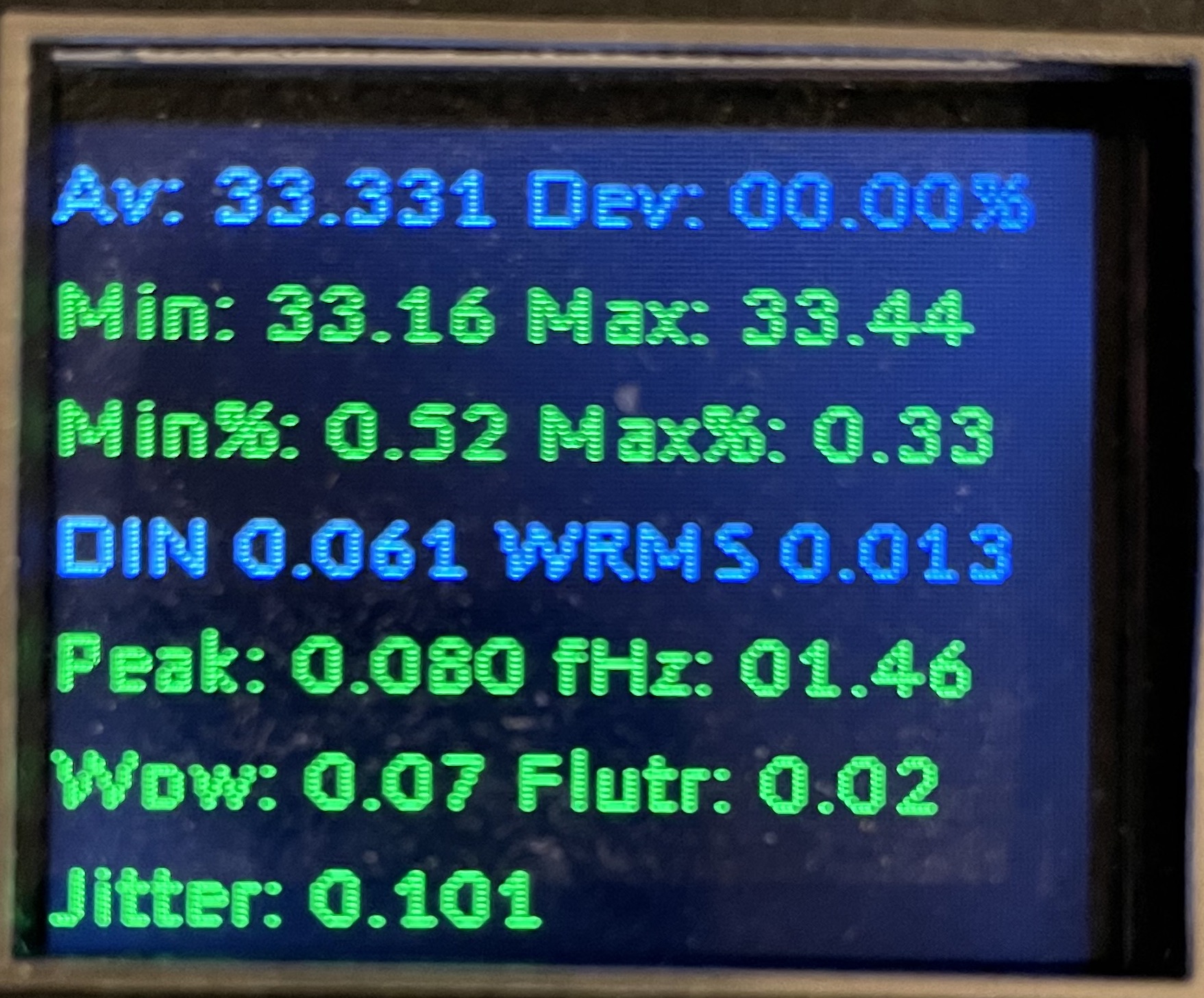 The test report on the Shaknspin unit
The test report on the Shaknspin unit
The factory speed setting according to the app was 33.32, for all intents and purposes perfect, but the average speed was even better: 33.331, with a percent deviation of 00.00%. I don’t recall ever before seeing all zeros.
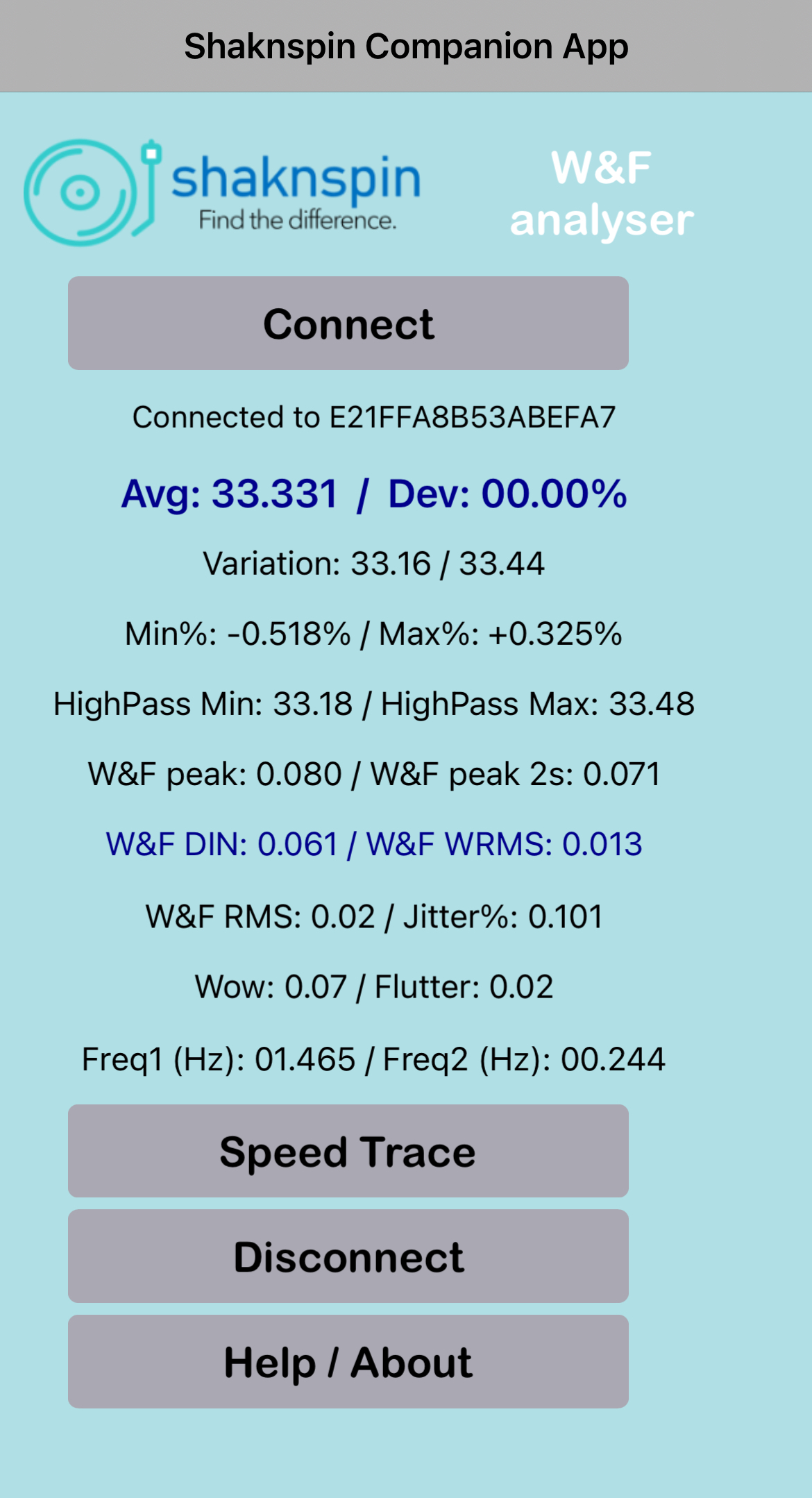 the test report delivered by the Shaknspin app
the test report delivered by the Shaknspin app
Impulse type “tap tests” don’t necessarily define turntable isolation but they are helpful. I’ve had some big, heavy turntables here with elaborate isolation feet that passed everything, especially low frequency components of both platform and plinth taps. Footer cosmetics don’t isolate.
Naia’a low mass, hollowed out feet isolated effectively, especially at the lower frequencies, and the plinth (what there is of it), was in most locations equally effective at impulse dissipation, producing a “tight”, fast, quick to evaporate “pip” instead of a “thump”— with less “tap” transmitted the closer to the tonearm I tapped, not at all surprising given the location of the double ceramic braces. The RB titanium was also extremely well-damped. Tapping on it with the volume well up produced silence.
In other words, I went into the listening part of the review filled with optimism.
Me No Denia the NAIA
I exited the review feeling the same way I went into it, so let’s avoid any drama. The NAIA is the turntable Rega has, for decades, been aiming for, which is not to say the ones below are not successful designs! The NAIA epitomizes and its sonic performance confirms the design philosophies so fully explored in the book referenced at the beginning of this review.
No, I did not have a Planar 10 here to “A/B” with the NAIA, so there’s that, and the Aphelion 2 is new to me but when you hear a turntable that produces this kind of quiet and obvious speed stability and accuracy, you hear it. It actually helped, not hindered to have two $200K turntables on hand during this review. I could hear where the far less costly NAIA competes and where it doesn’t. That a turntable costing 1/20 as much competes in any parameters is impressive!
I used multiple phono preamps including the inexpensive $439 Schiit Skoll at the bottom of the price ladder and the $52,000 Ypsilon VPS-100 (SE) (silver wound transformers, silver internal wire, and silver connectors) at the top, in conjunction with various step up transformers that will be reviewed shortly, as well as with Ypsilon’s own large MC-16L and MC-26L.
Before listening to anything I was determined to add to the review how the NAIA sounded with other cartridges but once I got into the review I found the Aphelion 2’s sonic and mechanical performance so attractive and satisfying I decided to just review the “as delivered” combo, especially considering that anyone can pretty much unbox and perfectly set it up in a matter of minutes.
The Aphelion 2’s timbral balance—at least when used with the NAIA, is as neutral a moving coil cartridge as I’ve heard, which is not to say it matches or betters in all ways the best I have here that cost as much as the turntable, but the Aphelion 2 gets well out of the way and just delivers the goods, dynamically, timbrally and with its "fine-line" stylus, transients and soundstage details that will have listeners who have not experienced top echelon 'front ends', wide-eyed and wide-eared.
If the NAIA sounds this good with Rega’s own cartridge I’m sure if you choose to pair it with something more costly and exotic, you’ll get the desired results (but only if you send the cartridge off to WallyAnalog for a complete evaluation and appropriate shims to correctly set VTA/SRA, azimuth and even zenith angle).
One of the first records I played was Vivaldi in London (VALDC017) a brand new double direct-to-disc title from Chasing the Dragon performed by Interpreti Veneziani and recorded at Air Studios, a venue I was lucky enough to visit for another Chasing the Dragon Production, so I have a good handle on the large open space’s acoustics.

Side B’s “Concerto for violin, strings and harpsicord” presented the nine musician ensemble as shown in the jacket art, though not with each in an exaggerated defined space, because the room’s natural reverb doesn’t allow that, but rather as a coherent ensemble in a well-defined space. You could more easily “see” the cello and double bass off to one side but still well integrated with the picture.
Instrumental textures were supple and delicately drawn, and timbres were accurate. The violins were never screechy, the double bass and cello never suffered bloat. A testament to the recording engineer too of course, and the room, which was offered in impressive relief behind the musicians and a series of arrayed baffles.
But I played the same record as well on two 20X the price rigs, where cartridges alone were NAIA-priced and while you’d easily hear the differences, the NAIA/Aphelion combo produced equally stable, well defined and fully satisfying images and soundstaging. Rock solid and well-focused. Especially impressive was the NAIA’s attack-delicacy on the strings.
JoE Silva’s Band on the Run 50th Anniversary Edition review piqued my curiosity so I laid out the $50 bucks and bought a copy. I’m generally not a fan of Miles Showell’s ½ speed mastered cuts from digital files, though it’s difficult to know who’s responsible, Miles or the engineers who prepared the digital files.
In this case, they all did an excellent job overall, re-inventing the record for 21st century ears. It’s an enjoyable listen filled with detail surprises and clarity, though as usual, attack subtlety, sustain, decay and especially instrumental textures take a hit to produce that, and depth flattens. All the microdynamic cues that differentiate “real” from “mechanical” get lost. If you don’t know they were there you won’t miss them.
Compare Paul’s bass on “Mrs Vandebilt” on the original versus the reissue. One is “deep bass” and the other are bass strings vibrating. The NAIA dug out and effortlessly presented all these differences in ways only better turntables manage.
If you want Paul in the room, or wish to hear percussion on “Bluebird” sound startlingly real, or get the full bass textures as Paul plucks the strings, get an original U.K. It’s got space, three-dimensionality and filled with sonic “love” in place of “clinical precision”.
The NAIA laid bare all of those differences and when I compared them again and listened to both on the NAIA and on the 20X rigs, what most impressed about the NAIA was its bottom end control, speed and clarity. It didn’t exaggerate and produce false bass extension mud nor did it truncate or attenuate the bass on the record.
On the original Band on the Run pressing, the NAIA expressed every one of its positive qualities including on the title tune the superiority of the drum smacks, and especially the subtle echo behind the vocals. On “Jet” there’s that nasty opening diesel truck like synth accent that had full weight and snarl backed by a deep bass accent. The sixteenth note piano fills on the tune were cleanly presented and most importantly the entire presentation hung together three-dimensionally and in all the ways only great turntable and cartridge combos manage. I think Geoff Emerick would approve (but perhaps not so much with the reissue).
To hear the full benefits of this turntable’s background quiet and speed accuracy and the Amphelion 2’s exceptional tracking abilities, check out a well-recorded and pressed solo piano recital like The Lost Recordings double LP stereo release Emil Gilels Amsterdam 1976 recorded at Amsterdam’s Concertgebouw. It’s limited to 2000 copies, but it appears a few remain. Kevin Gray cut from carefully prepared high resolution files and here the goal was not to “modernize” but rather to present what’s on the tape, which I guess needed some digital domain prep.
Whatever the reason or reasons for digitization, the stereo sound puts you in the hall, with the piano presented with three-dimensional clarity and stability. The large reverberant space behind amplifies the reality without interfering with either the well-defined piano’s image, or with Gilels unlimited macro and micro dynamic expression.
Finally, after reading somewhere about a botched digital transfer of Benny Carter’s Further Definitions (Impulse AS-12), I pulled out and played the original, mastered by Rudy Van Gelder. Recorded in 1961 by Johnny Cue, with whom I’m unfamiliar (a different engineer gets credit for the mono edition), it features Coleman Hawkins, Jo Jones, Phil Woods, Charlie Rouse, Dick Katz, Jimmy Garrison and (guitarist) John Collins in parenthesis because I never heard of him either.
Four saxes, piano, guitar, bass and drums impeccably arranged by Carter and performed by greats, many from the “old school” but some like Garrison, Woods and Rouse (who was moonlighting from Thelonious Monk’s group). Garrison, still in his 20s, would join Coltrane the next year but by the time this was recorded he’d already played with many greats.
A fun big band record in which the saxes can either sound hard and somewhat brittle or sail on smoothly as they did through the NAIA/Aphelion 3 combo. On Duke Elllington’s “Cotton Tail” there’s subtle guitar comping center channel throughout, Katz’s cleanly recorded piano on the left channel, with plenty of surrounding space and sax solos by Carter, Rouse, Woods and Hawkins, the four spread two left, two right. On “Body and Soul” with no drums, Garrison’s bass carries the rhythmic load, each pluck cleanly rendered oh so subtly center channel. Truly black backgrounds spotlight the delicate interplay. Classic stuff recorded near the end of an era. The NAIA's resolution of low level detail and microdynamic expression on that recording and many others I played puts it in a performance tier above its price point.
This Mat Not That
The Italian company Sublima Audio Research manufactures and sells Mat Chakra in standard (190 euro) and Limited editions. You have to get past the stones and other products that will turn off many visitors, but please plow through to the mats! You’ll find a link to a review I wrote and an explanation of how this sandpaper-like mat works.

I used both for much of this review, in place of the supplied standard white fiber mat. If you own a Planar 8 or Planar 10 I encourage you to give this super thin, stiff mat a try. The difference it made on the Naia was substantial IMO, good as the sound was with the supplied mat. The Mat Chakra intensified the black backgrounds, produced better defined transients especially bass transients and to my ears made everything sound more precise, three-dimensional and vivid. I know the Rega folks won't appreciate this part of the review but that's what I heard, though you can be sure this turntable produced spectacular sonic performance using the supplied mat.
Conclusion
The NAIA presents an exquisitely tight ship for a record to sail on. Both the arm and ‘table take Rega’s thinking to the limits without totally breaking the bank to Naiad territory.
Stopping at NAIA makes sense because according to Rega, while NAIA can be a production assembled product, Naid cannot, and because once you’re in $45,000 territory there’s very serious (but not as stiff) competition.
Skeptics will look at the NAIA and think it can’t possibly be twice as good as the Planar 10 though it costs twice as much. As with all things audio, the laws of diminishing returns apply. I can’t say the NAIA is twice as good as the Planar 10 but I can say with complete confidence that it’s much better in every way and the measured performance demonstrates that the NAIA is a step above the Planar 10 and above much of the competition at any price. It's that good.
Because the Aphelion 2 is so far advanced from the original Rega MCs I’ve heard, the combination produces timbrally neutral, well- balanced sound and it tracks better than any MC I’ve tested using Ortofon’s test record. The cartridge is a fitting NAIA companion.
Rather than closing with the usual audiophile checklist, which this turntable checks off with ease, I'd rather close with this: I feel confident in writing that if you get to hear this turntable and cartridge combo in a proper setting at a store, or at a show, you'll easily hear how good it is and how much musical fun and rich detail it effortlessly delivers, while just sounding "right".
If you encounter reviews claiming the NAIA/Aphelion 2 is “all anyone will ever need” or “performs as well as turntables costing ten times as much”, well those reviewers either are satisfied campers at a different performance level or have been listening to the wrong top tier turntables. There are some not such good ones that the NAIA beats, especially in terms of speed stability rhythmic polish and even background quiet, but it's not the "ultimate", though it might be within its price point and probably beyond.
Put it all together and you have a remarkably compact, lightweight, high performance package that at $16,999 is costly but not impossibly so and that can be taken out of the box, perfectly set up and playing records within ten minutes. If there's another turntable that combines all of these attributes at the NAIA's price I haven't seen or heard it—and I've seen and heard plenty!
Meanwhile, below the album art, find the same Anthony Wilson track you can listen to in the review of his new album recorded using the 200K+ rig, recorded again using the NAIA/Aphelion 2 combo (with Rega's mat), and the Ypsilon VPS-100/Ypsilon MC-16L SUT combo.
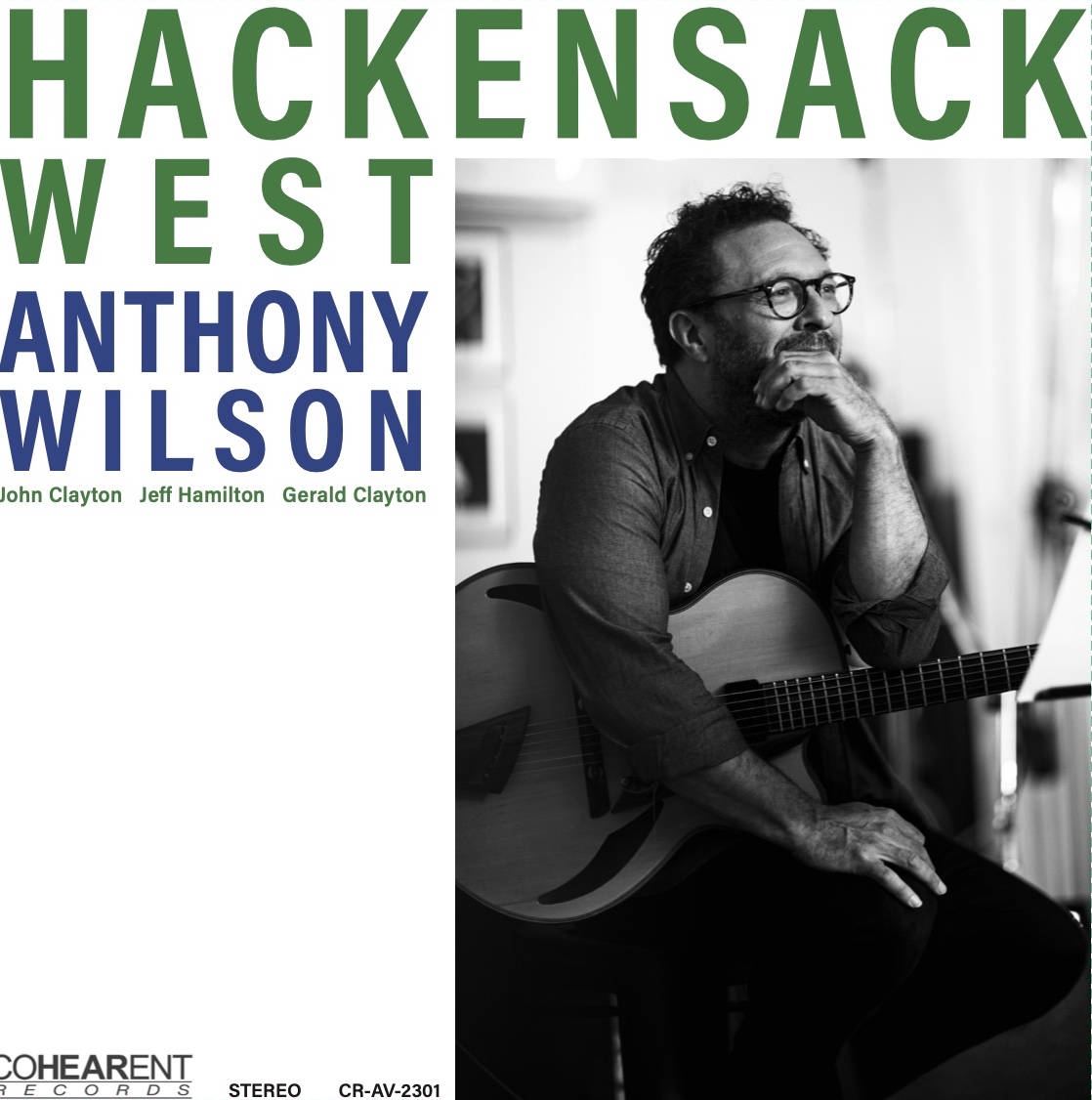
Specifications
Tonearm: RB Titanium
Cartridge: Rega Aphelion 2 MC
Plinth: Graphene Impregnated Carbon Fibre and a Tancast 8 polyurethane foam core
Motor: 24 V low noise motor with NAIA reference power supply
EBLT Triple Belt Drive
Aluminium hub and ZTA hub bearing assembly
Height: 4.5"
Length: 16.5"
Width: 13.8"
Weight: 17.0 lbs


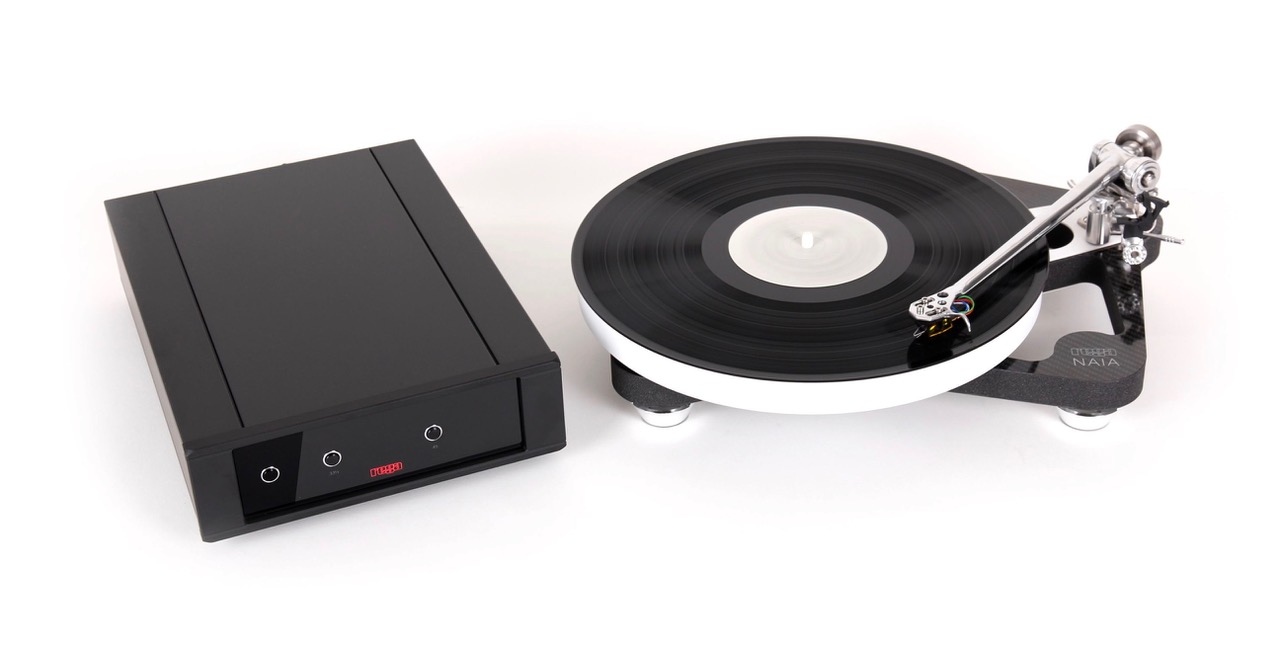







































.png)








